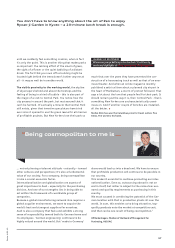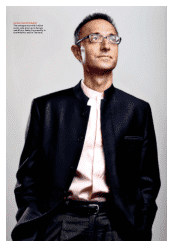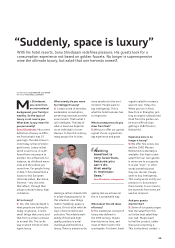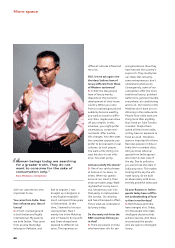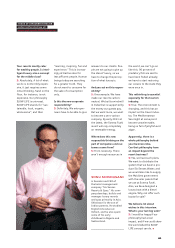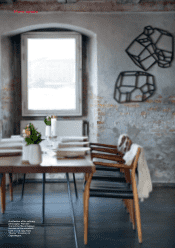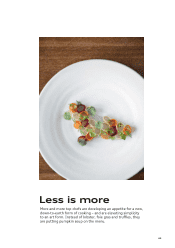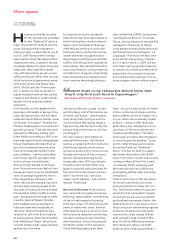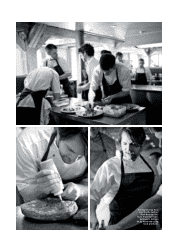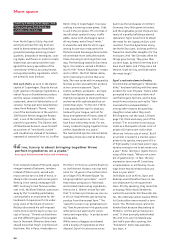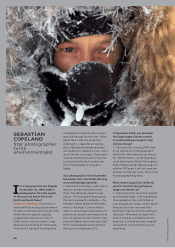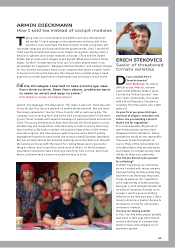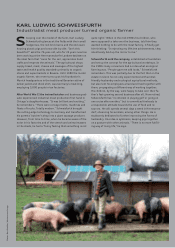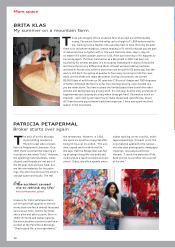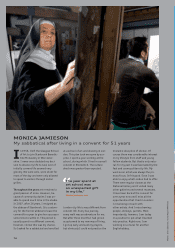Audi 2009 Annual Report Download - page 69
Download and view the complete annual report
Please find page 69 of the 2009 Audi annual report below. You can navigate through the pages in the report by either clicking on the pages listed below, or by using the keyword search tool below to find specific information within the annual report.
More space
66
from North Cape to Sicily: Any chef
aiming to achieve the very best will
need to demonstrate profound back-
ground knowledge spanning product
qualities, preparation techniques, cook-
ing styles, and flavors in order to create
dishes that can easily hold their own
against the luxury specialties of the
connoisseur’s Mecca, by using honest,
ecologically healthy ingredients, which
are primarily local produce.
One such chef is at work in the Danish
capital of Copenhagen. Despite his out-
right rejection of prestige ingredients, a
radical focus on Scandinavian produce
and the casual, relaxed decor of the
restaurant, devoid of tablecloths or sil-
verware, he has just been awarded two
stars: René Redzepi’s “Noma,” voted
one of the best eateries in the world in
2009 by the British magazine Restau-
rant, is one of the hottest tips on the
planet for gourmets. This Danish chef,
of Macedonian descent, views himself
as a pioneer of “new Nordic cuisine” –
wild cloudberries instead of tomatoes,
rapeseed oil instead of olive oil, truffles
from Gotland instead of Périgord, apple
vinegar instead of balsamic, reindeer
instead of Ibérico pork, served with
musk oxen tartar on a bed of moss, or
sheep’s milk mousse with sorrel gratin.
Writing in the weekly newspaper DIE
ZEIT, Germany’s most famous restau-
rant critic, Wolfram Siebeck, was blown
away by the “incredibly painstaking
cooking that is as impressive for the
handiwork it requires as for its under-
lying vision of the future of cuisine.”
Redzepi discovered his self-imposed
restrictions to be the key to a new con-
cept of luxury: “I found out that there
are 150 different types of horseradish
here in Denmark. Whoever dines here
should know that they’ll only find such
food here. Not in Paris, Amsterdam or
Berlin. Only in Copenhagen. Top-class
cooking is entering a new phase. I like
to call it the eco phase. Prior to that, it
was all about opulent luxury: truffle
pâtés, caviar with champagne sauce –
all very heavy, and all very French.”
It should be said that for all its rigor,
among its one-star restaurants the
Michelin Guide has always demonstrat-
ed somewhat more latitude towards
those choosing to do things their own
way. The Hamburg-based Sicilian Anna
Sgroi, for instance, earned a Michelin
star for her “Anna e Sebastiano” restau-
rant in 1990 – the first Italian restau-
rant in Germany to receive that acco-
lade. She now cooks with incomparably
fearless purism and authentic produce
at her current restaurant “Sgroi.”
Lentils, sardines, pumpkins – all ingre-
dients from Italian peasant cooking
that Sgroi prepares to sheer perfection
and serves with sophisticated but un-
pretentious style. “In the end, I think
I was awarded the star for what you
taste with your tongue, and not for
fancy arrangements of foams, dabs of
sauce, towers and so on. I don’t con-
fuse flavor with pretty looks. For me,
luxury is about bringing together three
perfect ingredients on a plate.”
She has kindred spirits in Annie Féolde,
legendary three-star chef at Enoteca
Pinchiorri in Florence, and the South Ty-
rol chef Herbert Hintner, who has held
a star for 15 years in the northern Ital-
ian village of St. Michael/Eppan “by
bringing tradition up to date” – and if
that means using bacon, flat bread,
and smoked meats as key ingredients,
then so be it. Hintner knows full well
that “it is illusory to believe we can cov-
er all our requirements just by buying
produce from the nearest farm.” The
“quest for a soul in our globalized soci-
ety” that he perceives in his guests also
reflects his own yearning for prove-
nance and regionality – in products and
recipes alike.
While some colleagues are blessed
with a bounty of ingredients at their
disposal, Sgroi’s local sources are as
barren as the landscapes in northern
Germany. Very little game is hunted,
and the vegetables grown there are too
rarely of a quality befitting a starred
restaurant. Sgroi would love to obtain
the meat for her signature dish, oven-
roast kid, from the dyke farms along
the North Sea coast, but they prefer to
freeze the meat after slaughter for the
most part. And “the Germans often let
things grow too big. They grow their
zucchini huge, by which time they don’t
have much taste, and if they rear a kid
they let it get too big, and that makes
the meat tough.”
Sgroi’s soulmate down in Swabia,
Vincent Klink at Stuttgart’s “Wielands-
höhe,” has been battling with the same
problem for over 30 years. That is what
prompted him to create a network of
certified organic farmers, and he buys
meat from producers such as the “Herr-
mannsdorfer Landwerkstätten” –
among other reasons because they
slaughter calves when they reach
80 kilograms, not the usual 120 (see
page 71). Klink uses every part of the
animal: “I’m not averse to serving up
melts as a blanquette of veal. A lot of
people still have some notion that
there are ‘inferior cuts of meat’. But if
an animal is reared in a manner appro-
priate to its species, every part of it is
of high quality. I even have sworn vege-
tarians coming to me to eat meat once
a year.” Klink, like Sgroi, rejects the pri-
macy of the visual: “We are not a tem-
ple of gastronomy – in fact, the very
expression turns me off. I avoid any
ornamentation or artificiality. You al-
ways know exactly what product you
have on your plate.”
Individuals such as Klink, Sgroi and
Redzepi would therefore have no rea-
son whatsoever to relinquish their
stars. Strictly speaking, they cannot do
so anyway. When Alain Senderens
wanted to surrender his three-star sta-
tus, the otherwise rather evasive Miche-
lin Guide editors were moved to com-
ment: “No, Michelin stars cannot be
handed back because they belong to
Michelin, not the person being hon-
ored.” It then promptly admonished
the chef in its own inimitable way:
Just half a year after opening, the
“Senderens” bistro was awarded …
two stars.
“
For me, luxury is about bringing together three
perfect ingredients on a plate.”
Anna Sgroi, Michelin-starred Italian chef in Hamburg
VISIT TO A MICHELIN-STARRED CHEF
Take a look over René Redzepi’s
shoulder in the kitchen:
w
wwwww..aauuddii..ccoomm//aarr22000099//ttooppcchheeffss



